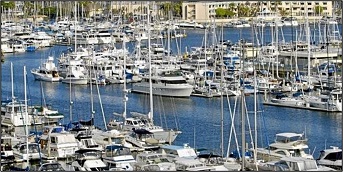Template established for how boat harbors could modify copper regulatory targets

SCCWRP and its partners have completed a three-year study that establishes a template for how Southern California boat harbors could pursue scientifically validated modifications to default regulatory targets for dissolved copper levels on a site-specific basis.
The study, which focused on Marina del Rey Harbor in Los Angeles County, found that the default regulatory standard of 3.1 ug/L for copper in the harbor could be set higher while still adequately protecting marine life from this contaminant. Raising the default regulatory target for a pollutant is a regulatory process known as setting a site-specific objective.
Under the harbor’s existing Total Maximum Daily Load (TMDL) regulatory target, water-quality managers are required to reduce copper loading by about 85%, which would require boat owners to make significant changes to the types of anti-fouling paint they typically use on boats. Copper is added to boat paint to prevent barnacles and other marine life from attaching to and growing on the vessels’ underside.
Water-quality managers and harbor operators are closely watching Marina del Rey – the largest small-boat harbor in North America – as it has the potential to become the first boat harbor in Southern California with a site-specific water-quality objective for copper. Multiple other harbors in the region are facing similar copper TMDL challenges, including Shelter Island Yacht Basin in San Diego County and Newport Harbor in Orange County.
If water-quality managers elect to pursue changing Marina del Rey’s regulatory target for copper, the SCCWRP-led study would serve as the scientific justification for such a change. Marina del Rey’s copper objective could be set somewhere between 4.1 and 4.3 ug/L, up from the existing 3.1 ug/L maximum, according to the study’s findings. Although no decisions have been made yet, this hypothetical scenario would not eliminate the need for copper-free paints altogether; it would, however, reduce the number of boats required to replace their bottom paint.
During the study, which was published in August as a SCCWRP technical report, researchers used an approach known as the Water Effects Ratio (WER) – endorsed by the U.S. Environmental Protection Agency – that enables researchers to evaluate the effects of local water-quality characteristics on copper toxicity.
Although the default regulatory target for copper in California boat harbors is set based on the results of standardized laboratory toxicity tests that use laboratory-clean seawater, natural factors such as dissolved organic carbon can bind copper, reducing its bioavailability to marine life.
In Marina del Rey’s case, natural factors in the harbor’s seawater reduce copper bioavailability, giving water-quality managers the option to pursue raising the cap on copper concentrations.
Setting a site-specific objective is a public process that can take years. If successful, the public process in Marina del Rey Harbor would culminate with the Los Angeles Regional Water Quality Control Board adopting the site-specific objective in the region’s Basin Plan.
For more information, contact Ken Schiff.
More news related to: Runoff Water Quality, Sediment Quality, Top News